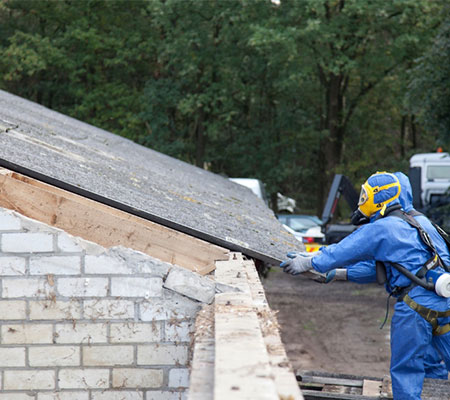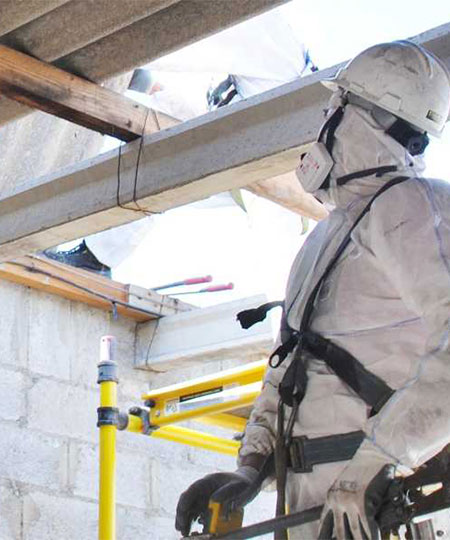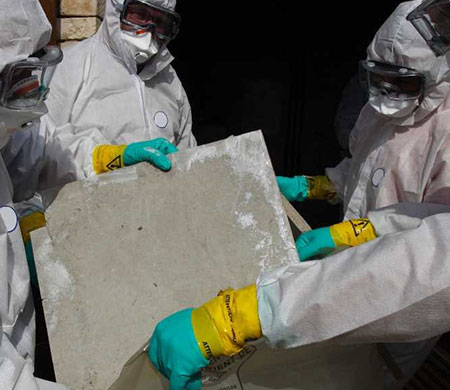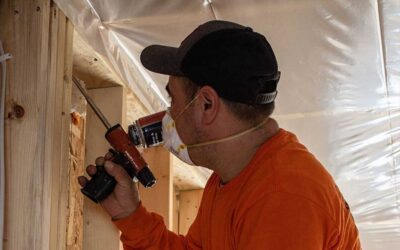What You Need to Know to Keep Your Family Safe
If you’ve been through a house fire or wildfire, your first concern is likely your family’s safety and what’s next. But there’s a hidden danger many don’t think about- asbestos exposure. Many older Washington homes were built with asbestos containing materials in building materials like insulation, siding, and popcorn ceilings. Fires can damage these materials and release dangerous asbestos fibers into the air and ash.
This guide will help Washington homeowners and contractors understand the health risks of asbestos exposure and outline the steps you can take to stay safe and legally compliant.
Understanding Asbestos in Washington Homes
Asbestos is a heat-resistant mineral once used widely before 1980 in construction for insulating and fireproofing. In Washington, you might find it in:
- Insulation, siding,cement asbestos board, and vinyl floor tiles.
- Popcorn ceilings and textured wall finishes.
- Vermiculite attic insulation, often sold as “Zonolite” and found in over 50,000 homes across the state.
Washington does not require the removal of intact, existing asbestos in homes. Under normal conditions, these materials may not be harmful if left intact and undisturbed. But during a fire, the high heat can damage the materials and send microscopic asbestos fibers into the air. Smoke and wind can carry those fibers far beyond the fire site.
How Fire Increases Asbestos Exposure Risk
Fires can spread asbestos fibers through smoke and ash. First responders face high risks, especially in older homes that are burning. The danger isn’t obvious. Fibers are invisible, have no smell, and health risks often appear decades later.
The biggest threat comes during cleanup:
- Walking through ash
- Sweeping or vacuuming debris
- Moving or hauling rubble
Fibers can cling to your clothing, shoes, and tools, spreading into vehicles or temporary housing. Washington law considers fire debris as demolition waste which triggers specific handling rules.
Health Stakes – Why Asbestos Exposure Is Serious
Not everyone will develop health problems from being exposed to asbestos. But for some, inhaling asbestos fibers can lead to severe health issues:
Mesothelioma
- A rare, aggressive cancer of the lungs and sometimes the abdomen cavity.
- It’s linked almost exclusively to asbestos.
- It can take 20–50 years to appear and is often fatal.
Lung cancer
- Caused by inhaling fibers.
- Risk increases significantly if you smoke.
Asbestosis
- A lung disease marked by scarring and chronic breathing issues.
- Smoking increases the risk of developing the disease.
- There’s no cure.
Health Stakes – Why Asbestos Exposure Is Serious
Not everyone will develop health problems from being exposed to asbestos. But for some, inhaling asbestos fibers can lead to severe health issues:
Mesothelioma
- A rare, aggressive cancer of the lungs and sometimes the abdomen cavity.
- It’s linked almost exclusively to asbestos.
- It can take 20–50 years to appear and is often fatal.
Lung cancer
- Caused by inhaling fibers.
- Risk increases significantly if you smoke.
Asbestosis
- A lung disease marked by scarring and chronic breathing issues.
- Smoking increases the risk of developing the disease.
- There’s no cure.
There’s no completely safe level of asbestos exposure. Risk increases with the amount and length of exposure. Most illnesses are seen in workers with long-term exposure, but even brief contact isn’t without risk. Prevention is key.
Safety Steps for Homeowners After a Fire
1. Wait for Official Clearance
Don’t return until authorities say it’s safe. If your home was built before 1980, assume it contains asbestos. Firefighters take extra precautions so you should too. If you live nearby, keep your windows and doors shut to avoid exposure.
2. Use Protective Gear if Entry Is Necessary
Wear a respirator rated N95 or P100, disposable coveralls or old clothing, gloves, boots, and safety glasses. Cover all skin. Bag clothes after use and shower immediately. Seal your retrieved items until they can be cleaned.
3. Avoid Disturbing Debris
Never sweep, dust or vacuum dry ash. Avoid using regular vacuums, fans, or leaf blowers. Lightly mist debris before moving it. Keep your pets and children away. Avoid tracking ash indoors.
4. Get a Professional Asbestos Inspection
Before cleanup, hire an AHERA-certified inspector. This is required before any major clean up or demolition can take place. They’ll take samples and send them to a lab. If tests come back negative, great. If positive, you’ll need professional asbestos removal to ensure everything is safely and properly removed.
5. Use a Professional Abatement Company
Don’t try to handle asbestos yourself. While Washington State Department rules allow homeowners to remove asbestos, it’s not recommended. Hire licensed asbestos abatement contractors who have the gear and knowledge to do it right.
Professionals have:
- HEPA-filter vacuums
- Containment systems
- Legal removal and disposal methods
6. Dispose of Debris Lawfully
Asbestos debris is considered hazardous/demolition waste. It cannot be buried on your property. A Notice of Intent (NOI) must be filed with your localclean air agency and the debris taken to an approved landfill.
7. Consider Your Neighbors
Let nearby residents know if your property has tested positive. If you’re near a burned structure, consider air testing. Watch for updates from your local health department.
Washington Resources and Regulations
Key agencies to know:
Washington State Department of Labor & Industries (L&I)
- Certifies asbestos abatement contractors
- Provides training info
- Maintains professional directories
Local Clean Air Agencies
- Spokane Regional Clean Air Agency, Puget Sound, etc.
- Oversee asbestos notifications and enforcement.
- Provide fact sheets.
- May waive fees during declared emergencies.
Washington State Department of Health (DOH)
- Provides general asbestos info.
- Gives testing lab referrals.
- Recommends cleanup best practices.
Federal Guidelines
- EPA’s NESHAP regulations cover demolition and disposal safety.
- OSHA PPE requirements set rules for protective gear and training.
Trust Your Local Experts
Don’t take chances with your health or your project. Whether you’re a homeowner or contractor, The Specialty Group is the Inland Northwest’s trusted name in asbestos removal and environmental safety.
Since 1983, our Specialty Environmental branch has helped families and builders across Spokane, Coeur d’Alene, and beyond stay safe with certified inspections, legal disposal, and full-service abatement. Our team is licensed, experienced, and ready to support you with prompt, affordable service.
Contact us today to schedule your inspection or receive a free consultation.
References
“Asbestos.” Washington State Department of Health, https://doh.wa.gov/community-and-environment/contaminants/asbestos. Accessed 2025.
“Asbestos and Natural Disasters.” Asbestos.com, www.asbestos.com/asbestos/natural-disasters/. Accessed 2025.
“Fire Damaged Structures & Asbestos: A Quick Review of Initial Steps.” Spokane Regional Clean Air Agency, https://spokanecleanair.org/fire-damaged-structures-asbestos-a-quick-review-of-initial-steps/. Accessed 2025.
“Fire Debris and Asbestos Fact Sheet.” Spokane Regional Clean Air Agency, Aug. 2023, https://spokanecleanair.org/wp-content/uploads/Aug-2023-fire-asbestos-final-fact-sheet.pdf. Accessed 2025.
“Protect Your Family from Asbestos-Contaminated Vermiculite Insulation.” United States Environmental Protection Agency, April 2025, https://www.epa.gov/asbestos/protect-your-family-asbestos-contaminated-vermiculite-insulation. Accessed 2025.






